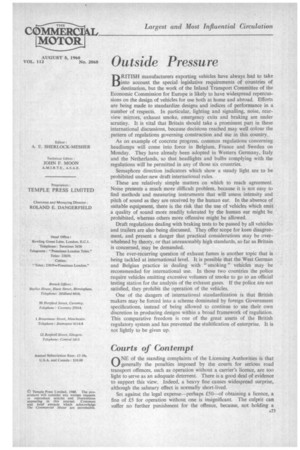Outside Pressure
Page 25

If you've noticed an error in this article please click here to report it so we can fix it.
BRITISH manufacturers exporting vehicles have always had to take into account the special legislative requirements of countries of destination, but the work of the Inland Transport Committee of the Economic Commission for Europe is likely to have widespread repercussions on the design of vehicles for use both at home and abroad. Efforts are being made to standardize designs and indices of performance in a number of respects. In particular, lighting and signalling, noise, rearview mirrors, exhaust smoke, emergency exits and braking are under scrutiny. It is vital that Britain should take a prominent part in these international discussions, because decisions reached may well colour the pattern of regulations governing construction and use in this country. As i..vi example of concrete progress, common regulations concerning headlamps will come into force in Belgium, France and Sweden on Monday. They have already been adopted in Western Germany, Italy and the Netherlands, so that headlights and bulbs complying with the regulations will be permitted in any of those six countries. Semaphore direction indicators which show a steady light are to be prohibited under new draft international rides. These are relatively simple matters on which to reach agreement. Noise presents a much more difficult problem, because it is not easy to find methods and measuring instruments that will assess intensity and pitch of sound as they are received by the human ear. In the absence of suitable equipment, there is the risk that the use of vehicles which emit a quality of sound more readily tolerated by the human ear might be prohibited, whereas others more offensive might be allowed. Draft regulations dealing with braking tests to be passed by all vehicles and trailers are also being discussed. They offer scope for keen disagreement, and present a danger that practical considerations may be overwhelmed by theory, or that unreasonably high standards, so far as Britain is concerned, may be demanded. The ever-recurring question of exhaust fumes is another topic that is being tackled at international level. It is possible that the West German and Belgian practice in dealing with " smoking " vehicles may be recommended for international use. In those two countries the police require vehicles emitting excessive volumes of smoke to go to an official testing station for the analysis of the exhaust gases. If the police are not satisfied, they prohibit the operation of the vehicles. One of the dangers of international standardization is that British makers may be forced into a scheme dominated by foreign Government specifications, instead of being allowed to continue to use their own discretion in producing designs within a broad framework of regulation. This comparative freedom is one of the great assets of the British regulatory system and has prevented the stultification of enterprise. It is not lightly to be given up.




































































































